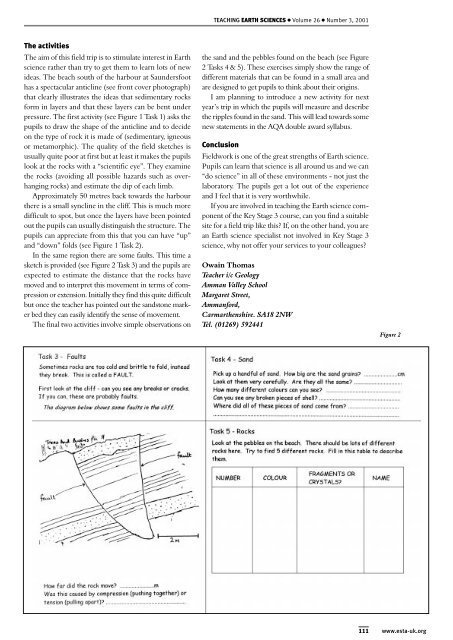teaching - Earth Science Teachers' Association
teaching - Earth Science Teachers' Association
teaching - Earth Science Teachers' Association
Create successful ePaper yourself
Turn your PDF publications into a flip-book with our unique Google optimized e-Paper software.
TEACHING EARTH SCIENCES ● Volume 26 ● Number 3, 2001<br />
The activities<br />
The aim of this field trip is to stimulate interest in <strong>Earth</strong><br />
science rather than try to get them to learn lots of new<br />
ideas. The beach south of the harbour at Saundersfoot<br />
has a spectacular anticline (see front cover photograph)<br />
that clearly illustrates the ideas that sedimentary rocks<br />
form in layers and that these layers can be bent under<br />
pressure. The first activity (see Figure 1 Task 1) asks the<br />
pupils to draw the shape of the anticline and to decide<br />
on the type of rock it is made of (sedimentary, igneous<br />
or metamorphic). The quality of the field sketches is<br />
usually quite poor at first but at least it makes the pupils<br />
look at the rocks with a “scientific eye”. They examine<br />
the rocks (avoiding all possible hazards such as overhanging<br />
rocks) and estimate the dip of each limb.<br />
Approximately 50 metres back towards the harbour<br />
there is a small syncline in the cliff. This is much more<br />
difficult to spot, but once the layers have been pointed<br />
out the pupils can usually distinguish the structure. The<br />
pupils can appreciate from this that you can have “up”<br />
and “down” folds (see Figure 1 Task 2).<br />
In the same region there are some faults. This time a<br />
sketch is provided (see Figure 2 Task 3) and the pupils are<br />
expected to estimate the distance that the rocks have<br />
moved and to interpret this movement in terms of compression<br />
or extension. Initially they find this quite difficult<br />
but once the teacher has pointed out the sandstone marker<br />
bed they can easily identify the sense of movement.<br />
The final two activities involve simple observations on<br />
the sand and the pebbles found on the beach (see Figure<br />
2 Tasks 4 & 5). These exercises simply show the range of<br />
different materials that can be found in a small area and<br />
are designed to get pupils to think about their origins.<br />
I am planning to introduce a new activity for next<br />
year’s trip in which the pupils will measure and describe<br />
the ripples found in the sand. This will lead towards some<br />
new statements in the AQA double award syllabus.<br />
Conclusion<br />
Fieldwork is one of the great strengths of <strong>Earth</strong> science.<br />
Pupils can learn that science is all around us and we can<br />
“do science” in all of these environments - not just the<br />
laboratory. The pupils get a lot out of the experience<br />
and I feel that it is very worthwhile.<br />
If you are involved in <strong>teaching</strong> the <strong>Earth</strong> science component<br />
of the Key Stage 3 course, can you find a suitable<br />
site for a field trip like this? If, on the other hand, you are<br />
an <strong>Earth</strong> science specialist not involved in Key Stage 3<br />
science, why not offer your services to your colleagues?<br />
Owain Thomas<br />
Teacher i/c Geology<br />
Amman Valley School<br />
Margaret Street,<br />
Ammanford,<br />
Carmarthenshire. SA18 2NW<br />
Tel. (01269) 592441<br />
Figure 2<br />
111 www.esta-uk.org

















